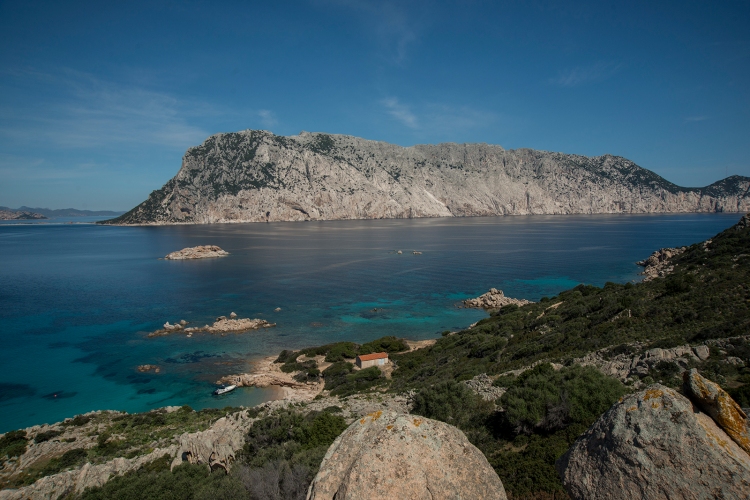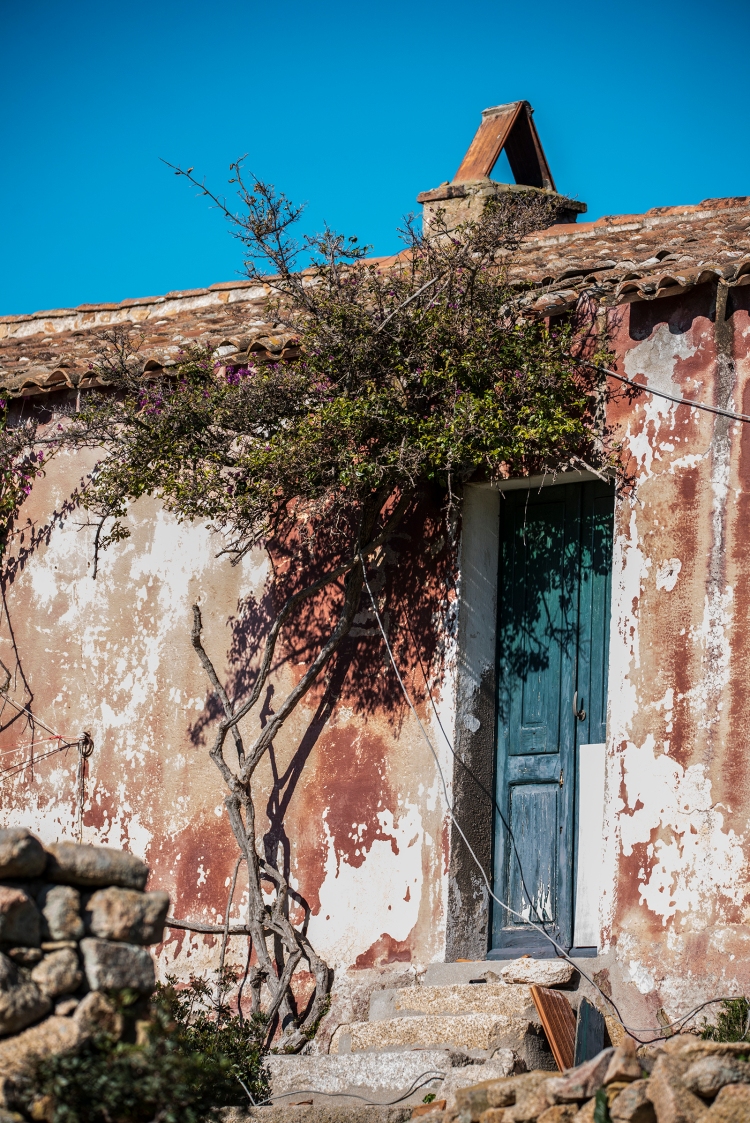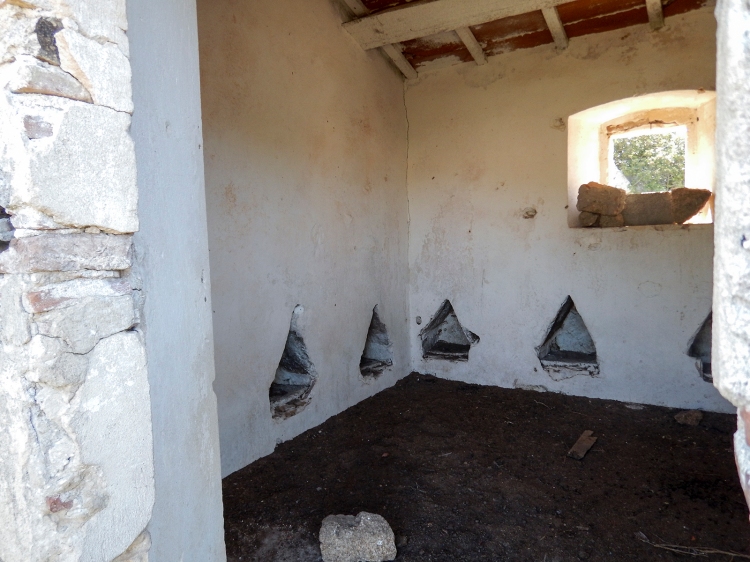The islands off Sardinian mainland are beautiful and different one from each other. And they’ve amazing stories to tell. Stories going back to ancient times or taking place in the 1900th. Among the ones I’ve heard, I find the recent story of Molara really fascinating. Molara is a granitic island off the north-east cost of Sardinia. It’s private and owned by a local family living on the Sardinian mainland. A basic dock allows to stop at Cala del Pastore, where there is a little sandy beach and an old house.

The landscape is great: little coves with colourful water, rocks and boulders shaped by the wind and some hills that offer incredible views over the sea and the impressive silhouette of Tavolara. This chance to have such a view is part of the fascination I feel for Molara!

But the recent signs of the human presence are another part I love too. At the beginning of the twentieth century, the island was an experimental farm as proved by the free-ranging livestock still grazing here. The man who has began this work was the great grand-father of the young man who told me this story.
At the end of the the 1800s, he became owner of some big properties and Molara was among these. Here, he decided to follow his ideas and realized an experimental farm. He built some houses, at the top of the island. The ruins are still there and every time I go I’m captured by the atmosphere and by the signs of the lives spent there. The owner family spent here the difficult time of the Second World War, escaping the bombing on the mainland.

The buildings apparently follow the traditional style and at the first glance they appear to be similar to any cluster of stazzi, the typical houses here in the north east of Sardinia. After a more careful look a lot of unusual details appears. In the master’s house, a bell, to call people for the meals was built near the kitchen and a courtyard surrounded with almond trees was probably the places where those meals took place during the good season. Old windows still opened over amazing views.


Among the other buildings there is the tiny cheese factory, and some equipment is still here. Then the house for the farmer and his family, inhabited until recent times by the caretaker, with a beautiful branch of bougainville decorating the front door. Near this the cattle shed and the big fence, called mandrione where at night the goats found shelter. On the little plane in front of the buildings we can find some other fences with stonewall and a little henhouse, with triangle-shaped niches. I’ve never seen another one like this in the whole of Sardinia!




Big Pine trees were planted and are now falling down, broken by the age and the wind. As are the two old chestnut trees, planted in the area called orto, vegetable garden, near an everlasting spring. This area enjoy the presence of fresh water all year round and is green and fresh during summer too. An incredibly big Myrtle has grown up here: a real tree, not a bush, with a bark as cracked as I’ve ever seen.
The water falling down from the vegetable garden spills until it reaches the sea. This wet track allows the Chaste trees (Vitex agnus castus) to grow and to flower with an astonishing purple stripe stretching down from the hill.
So, surrounded by gorgeous nature, you can feel this particular atmosphere, that it’s hard to define. It’s a little bit melancholic but it’s still possible to perceive the project of the original owner.

N.b. : the island is private and except for the coast border you need a permission to walk around.
Le isole attorno alla Sardegna sono belle e diverse fra loro, spesso hanno storie affascinanti da raccontare. Alcune sono storie antiche, lontane nel tempo, ma altre non meno intriganti, risalgono al Novecento. Fra i racconti che ho sentito, mi affascina la storia recente di Molara. Molara è un’isola granitica che si trova a nord-est della Sardegna. E’ proprietà di una famiglia locale che non ci abita stabilmente. Un approdo spartano consente di arrivare a Cala del Pastore, con la sua piccola spiaggia e la vecchia casa.
Il paesaggio è eccezionale: piccole cale con l’acqua chiarissima, si aprono fra le rocce e i grandi blocchi di granito, foggiati in forme incredibili dal vento. Alcuni rilievi offrono scorci sul mare e sulla silhouette dell’isola sorella, Tavolara. Sicuramente, la possibilità di godere di questa vista su Tavolara è uno dei motivi per cui apprezzo così tanto quest’isola!
Ma i segni recenti della presenza dell’uomo sono, per me, un altro aspetto ricco di fascino. Agli inizi del ventesimo secolo, l’isola era una fattoria sperimentale, come testimonia anche il bestiame che ancora pascola liberamente. La persona che iniziò la trasformazione dell’isola era il bisnonno di chi mi ha raccontato la storia.
Alla fine del milleottocento divenne proprietario di importanti possedimenti fra cui c’era anche Molara. Inseguendo una sua idea, decise di trasformarla e realizzò una fattoria sperimentale. Costruì alcune case, in cima all’isola. Le costruzioni, parzialmente in rovina, sono ancora lì e ogni volta che mi capita di andare, mi cattura l’atmosfera che si respira e mi perdo ad immaginare la vita delle persone che hanno abitato questi spazi. La famiglia del proprietario trascorse qui gli anni più duri della Seconda Guerra Mondiale, cercando di sfuggire ai bombardamenti che colpirono la terraferma.
Gli edifici apparentemente seguono lo stile tradizionale e a prima vista appaiono in tutto simili a qualsiasi gruppo di stazzi, le tipiche abitazioni del nord-est della Sardegna. Un’occhiata più attenta rivela numerosi dettagli che distinguono queste costruzioni da quelle visibili sulla terraferma. La casa padronale ha una campana esterna, costruita vicino alla cucina, probabilmente per richiamare le persone all’ora dei pasti. Un cortile interno, circondato di alberi di mandorlo era forse il posto dove questi pasti si consumavano durante la bella stagione. Vecchie finestre, ancora aperte, offrono scorci di grande bellezza.
Fra le altre costruzioni c’è un piccolo caseificio e rimangono, abbandonate, alcune vecchie attrezzature. A fianco sorgono le case dei fattori, che sono state abitate in anni recenti dalla famiglia del custode. Un ramo di bougainville decora la porta d’ingresso. Vicino le stalle e il grosso recinto, detto mandrione, dove durante la notte trovavano rifugio le capre. Sulla piana, di fronte alle altre costruzioni ci sono altri recinti con i muri a secco e un curioso pollaio, come non ne ho mai visto in Sardegna, con tante nicchie triangolari per accogliere le chiocce.
Grossi alberi di pino piantati in passato stanno ora cadendo, abbattuti dall’età e dal vento. Come i due vecchi alberi di castagno, piantati nell’area dell’orto, vicino ad una sorgente permanente. Questa ristretta zona gode della presenza di acqua lungo il corso dell’anno ed è sempre verde e fresca, anche durante l’estate. Un incredibile pianta di mirto cresce all’ombra: un vero e proprio albero, non un cespuglio, con una corteccia a scaglie, come mai mi è capitato di vedere.
L’acqua che scende dall’orto, arriva fino al mare. Questa traccia umida consente alle piante di Agnocasto di crescere e fiorire, con una inaspettata striscia viola e blu che colora la collina.
Così, circondati da una natura rigogliosa, possiamo avvertire l’atmosfera particolare che avvolge l’isola. E’ un poco malinconica, ma si percepisce ancora l’energia del progetto del primo proprietario.
N.b.. l’isola è privata, quindi salvo per la zona strettamente costiera, è necessario un permesso per accedere.

What a beautiful place to be❣️
LikeLike
Thank you Dina. I have a look to your blog, too. Amazing!
LikeLike
My grandparents worked on the farm back in 1950’s, what an amazing stunning place and lively memories told by my grandmother.
LikeLike